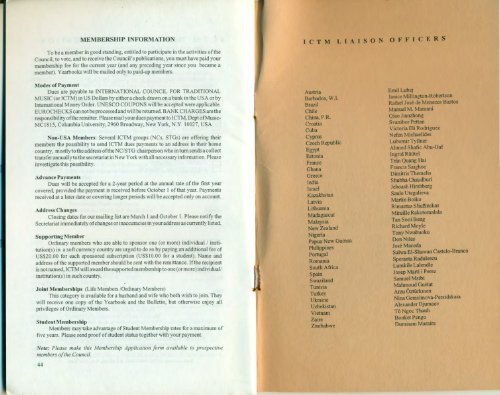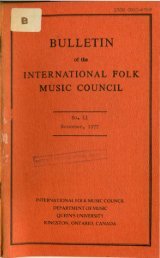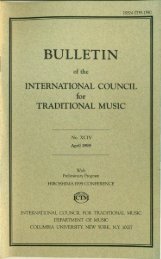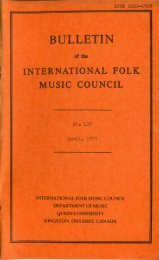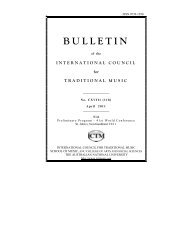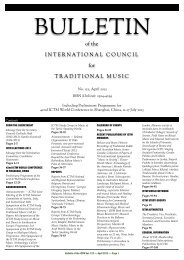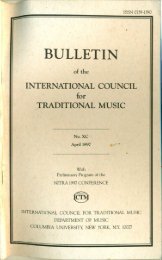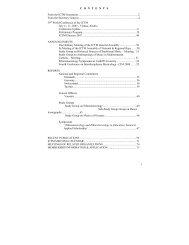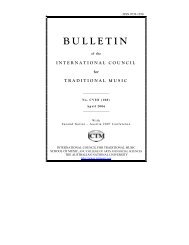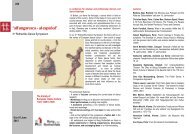Oct 1996 - International Council for Traditional Music
Oct 1996 - International Council for Traditional Music
Oct 1996 - International Council for Traditional Music
- No tags were found...
You also want an ePaper? Increase the reach of your titles
YUMPU automatically turns print PDFs into web optimized ePapers that Google loves.
were asked about features of dance repertoire, structure, style, and improvisation, anddemonstrations of the answers were elicited. In particular we tried various ways tocreate and document teaching contexts as a way to elicit this kind of demonstration andcommentary. Interviews also provided occasions in which aspects of in<strong>for</strong>mants' lifestoriesas a dancers, singers, musicians, etc., could be elicited to document context.While the shared experience and opportunity to learn from each other hasproven very rewarding <strong>for</strong> the participants in these projects, we hope now that thesepositive results can be more widely shared through publication. Colleagues in theStudy Group noted the potential value ofthe rich panoply of methods brought togetherin these experiments ifmade more widely accessible. The documentation itselfis alsovaluable original research material, if made accessible through a catalogue of thevoluminous recordings, notes, and photographs made. We concluded that while ourexperience in these projects has been important, and is already being used in our ownteaching, lecturing, and publication, this is not enough, and a call <strong>for</strong> contributions toajoint publication representing the work done in these two projects is nowcirculatingamong the participants. The enthusiasm expressed <strong>for</strong> such projects within the StudyGroup has been striking and there is widely expressed desire among other Study Groupmembers <strong>for</strong> more such opportunities.<strong>Oct</strong>ober 6, <strong>1996</strong> Colin QuigleySTUDY GROUP: IconographyEight <strong>International</strong> Meeting in Sedano (8urgos), Spain 15-19 May <strong>1996</strong>The idea of organizing a meeting on musical iconography in Spain originatedin a work session, held in Madrid in 1993 at the occasion of the world congress ofthe<strong>International</strong> <strong>Music</strong>ological Society. That session had an audience surpassing innumber and liveliness any other I can remember. This was a surprise <strong>for</strong> the Spanishcolleagues themselves and provided <strong>for</strong> them the incentive to organize a meeting <strong>for</strong>our Study Group in their country. It was put together by Maria Antonia Virgili(University of Valladolid) and myself and took place in a lovely conference center,situated like an Athos monastery in a small valley in orthern Castilia (Sedano,Province ofBurgos). As a topic we chose "<strong>Music</strong> and Dance in the Images of Popularand Courtly Feast in Southern Europe (1500 -1750)."A cornerstone in any historic research on per<strong>for</strong>ming arts is the knowledge ofmovement, playing technique, and instruments. Several papers examined paintingswith this question in mind, separating the naturalistic from the fictitious. Lynn M.Brooks (USA) showed that in Baroque art the interest of painters in naturalisticreproduction of body movements is quite high, although they apply the knowledgeeclectically. Barbara Sparti (Italy) found that almost the opposite is true <strong>for</strong> the 15thand 16th century. Elena LeBarbier (Spain) discussing an Asturian folk dance, arrivedat a similarly skeptical conclusion. The meaning of dance representations lies mostlyon the iconic level, they do not yield much <strong>for</strong> the reconstruction of movement. Andyet this does not necessarily diminish the value ofthe visual arts <strong>for</strong>thechoreologists.They are fascinating when examined with social and aesthetical concepts in mind.The discussion <strong>for</strong> music pictures moved along similar lines. Two colleaguesfrom Latin America (Egberto Bermudez, Colombia) and Victoria Eli Rodriguez(Cuba) examined material from that area. Cristina Bordas (Spain) revised theinterpretations of images of Franco-Spanish chamber music scenes, Alicia Gonzalesde Buitrago unearthed and discussed drawings of the Tarasca procession and CarmenRodriguez Suso (Spain) took a fresh look at pictures ofthe Charivari. The gist of this,group of papers wasthatthemain value of pictures lies intheability of artists to providethe onlooker with icons of musical reality and identifiers of social, religious, andaesthetic aspects of a given music culture. More often than not, the in<strong>for</strong>mation on theorganological side is secondary.Two other papers approached their subject from a completely different angle.Christopher Laferl (Austria) and Fernando Rodriguez de la Flor(Spain), both expertson Spanish literature and theater of the Golden Age, demonstrated that the mostimportant point on a poet's or writer's agenda is to verbalize the evocative qualitiesof musical sound, music making, and dancing. Rhetorical principles are at work. Justasa Spanish king oran Italian duke plan and design festivities and displays of politicalpower and noble glamour, writers use music in their designs of a world view - creatinga fictitious theater or a fictitious concerto of emotions, thoughts, and ideas.Somewhatin between the papers by musicologists and the scholars in literaturewere the contributions bytheater historian Andrea Sommer (Austria) and art historianTeresa Zapata Fernandez de la Hoz (Spain). Discussing images of feasts in Italy andSpain they successfully illuminated the middle ground where music reality andpictorial vision meet. A similar route of analysis was pursued by Franca Camiz (Italy)speaking about feasts ofBacchus, and Daniel Tercio (Portugal) providingan amusingglimpse at music making monkeys on ceramic tiles covering the facades of churchesand the walls of aristocratic gardens. And finally, Charles-Dorninique Luc (France)provided a socio-historical perspective using his paucity of pictorial and textualevidence <strong>for</strong> the city musicians of Toulouse as an explanation <strong>for</strong> the societal codesabout what was worthy of being preserved by a chronicler or illustrator and what not.A special session was arranged to give four students of the University ofValladolid an opportunity to present short papers.This meeting turned out to be one of the most successful we ever had. Someof the papers are presently being written as articles <strong>for</strong> Imago musicae. Plans areunderway <strong>for</strong> meeting again and <strong>for</strong> establishing centers of music-iconographicaldocumentation on the Iberian peninsula.14 August <strong>1996</strong> Tilman SeebassSTUDY GROUP: Computer Aided Research - Finland Meeting <strong>1996</strong>The annual meeting of the Study Group on Computer Aided Research washosted by the <strong>Music</strong> Department of the University of Jyvaskyla (Finland) from 27August to I September <strong>1996</strong> upon invitation by Prof. Helmi Louhivuori. The threemain topics ofthe conference were:Human and Technical Aspects of Database SystemsSupercomputing in EthnomusicologyThe Role of Networks <strong>for</strong> Ethnomusicology.After a short opening by the Director of the <strong>Music</strong> Department, Ewa Dahlig(Poland) gave an introduction to EsAC (musical code used by a more and moregrowing number of ethnomusicologists). Tunes encoded in EsAC (over 14 000)include folk melodies from Germany, Poland, Spain, Australia, China, Israel, as wellas children songs, Bach chorals, medieval church music, protestant hymns etc. Thisyear were added Northumbrian small-pipe tunes and Polish protestant folk tunes.Ulrich Franzke (Germany) wrote a new, improved version ofEsLA (EssenerLanguage) - a programming language designed especially <strong>for</strong> musicologists to makethe work with EsAC databases more efficient. In his presentation (Newest Functionsand Features ofEsLA) Ulishowed the new possibilities offered by his program. Later,22 23


